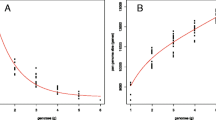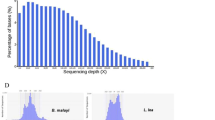Abstract
Bacillus thuringiensis (Bt) is efficient, strongly specific, and avirulent to humans, making it one of the most popular biopesticides in the world. Bt LLP29 is a mosquitocidal strain that was first isolated from Magnolia denudata. To understand its molecular mechanism against mosquitoes, the genome of Bt LLP29 was sequenced and annotated in this study. The LLP29 genome was found to have a total length of 5.99 Mb, with an average G + C content of 35.21%. A total of 6107 coding sequences were also detected, together with 42 rRNAs and 124 tRNAs and 135 other RNAs. With the help of annotation databases, including GO, COG, KEGG, Nr and Swiss-Prot, most unigene functions were identified. At the same time, a collinear analysis was performed on the genome of LLP29. There were also some virulence genes detected, including cry, chitinase, zwittermicin and vip.




Similar content being viewed by others
Data accessibility
NCBI gene bank https://www.ncbi.nlm.nih.gov/bioproject/PRJNA399840.
Abbreviations
- Bt:
-
Bacillus thuringiensis
- ICP:
-
Insecticidal crystalline proteins
- NCBI:
-
National Center for Biotechnology Information
- BLAST:
-
Basic Local Alignment Search Tool
- UV:
-
Ultraviolet
- GO:
-
Gene ontology
- COG:
-
Clusters of orthologous groups of proteins
- KEGG:
-
Kyoto Encyclopedia of Genes and Genomes
- SAM:
-
A kind of Map Samtools
- NR:
-
Non-redundant protein sequence database
- PIR:
-
Protein identification resource
- PR:
-
Protein resource
- PDB:
-
Protein data bank
- BWA:
-
Burrows–Wheeler alignment tool
References
Altschul SF, Madden TL, Schäffer AA, Zhang J, Zhang Z, Miller W, Lipman DJ (1997) Gapped BLAST and PSI-BLAST: a new generation of protein data base search programs. Nucl Acids Res 25:3389–3402. https://doi.org/10.1093/nar/25.17.3389
Ashburner M, Ball CA, Blake JA, Botstein D, Butler H, Cherry JM, Davis AP, Dolinski K, Dwight SS, Eppig JT, Harris MA, Hill DP, Issel-Tarver L, Kasarskis A, Lewis S, Matese JC, Richardson JE, Ringwald M, Rubin GM, Sherlock G (2000) Gene ontology: tool for the unification of biology. The gene ontology consortium. Nat Genet 25:25–29. https://doi.org/10.1038/75556
Beegle CC, Yamamoto T (1992) History of Bacillus thuringiensis Berliner research and development. Can Entomol 124:587–616. https://doi.org/10.4039/Ent124587-4
Blin K, Shaw S, Steinke K, Villebro R, Ziemert N, Lee SY, Medema MH, Weber T (2019) AntiSMASH 5.0: updates to the secondary metabolite genome mining pipeline. Nucleic Acids Res 47:81–87. https://doi.org/10.1093/nar/gkz310
Brar SK, Verma M, Tyagi RD, Surampalli RY, Barnabe S, Valero JR (2007) Bacillus thuringiensis proteases: production and role in growth, sporulation and synergism. Process Biochem 42:773–790
Bravo A, Likitvivatanavong S, Gill SS, Soberón M (2011) Bacillus thuringiensis: a story of a successful bioinsecticide. Insect Biochem Mol Biol 41:423–431. https://doi.org/10.1016/j.ibmb.2011.02.006
Chen F, Mackey AJ, Vermunt JK, Roos DS (2007) Assessing performance of orthology detection strategies applied to eukaryotic genomes. PLoS ONE 2(4):e383. https://doi.org/10.1371/journal.pone.0000383
Delcher AL, Bratke KA, Powers EC, Salzberq SL (2007) Identifying bacterial genes and endosymbiont DNA with Glimmer. Bioinformatics 23:673–679. https://doi.org/10.1093/bioinformatics/btm009
Doerks T, Copley RR, Schultz J, Ponting CP, Bork P (2002) Systematic identification of novel protein domain families associated with nuclear functions. Genome Res 12:47–56. https://doi.org/10.1101/gr.203201
Federici BA, Park HW, Bideshi DK, Wirth MC, Johnson JJ (2003) Recombinant bacteria for mosquito control. J Exp Biol 206:3877–3885. https://doi.org/10.1242/jeb.00643
Goldberg LH, Margalit J (1977) A bacterial spore demonstrating rapid larvicidal activity against Anopheles sergentii, Uranotaenia unguiculata, Culex univitatus, Aedes aegypti and Culex pipiens. Mosq News 37:355–358
Jeong H, Park SH, Choi SK (2014) Genome sequence of the acrystalliferous Bacillus thuringiensis serovar israelensis strain 4Q7, widely used as a recombination host. Genome Announc 3:e00214–e00231
Kanehisa M, Goto S, Kawashima S, Okuno Y, Hattori M (2004) The KEGG resources for deciphering the genome. Nucl Acids Res 32:277–280. https://doi.org/10.1093/nar/gkh063
Koren S, Walenz BP, Berlin K, Miller JR, Bergman NH, Phillippy AM (2017) Canu: scalable and accurate long-read assembly via adaptive k-mer weighting and repeat separation. Genome Res 27:722–736. https://doi.org/10.1101/gr.215087.116
Krogh A, Larsson B, von Heijne G, Sonnhammer EL (2001) Predicting transmembrane protein topology with a hidden Markov model: application to complete genomes. J Mol Biol 305:567–580. https://doi.org/10.1006/jmbi.2000.4315
Li R, Li Y, Zheng H, Luo R, Zhu H, Li Q, Qian W, Ren Y, Tian G, Li J, Zhou G, Zhu X, Wu H, Qin J, Jin X, Li D, Cao H, Hu X, Blanche H, Cann H, Zhang X, Li S, Bolund L, Kristiansen K, Yang H, Wang J, Wang J (2010a) Building the sequence map of the human pan-genome. Nat Biotechnol 28:57–63. https://doi.org/10.1038/nbt.1596
Li R, Fan W, Tian G, Zhu H, He L, Cai J, Huang Q, Cai Q, Li B, Bai Y, Zhang Z, Zhang Y, Wang W, Li J, Wei F, Li H, Jian M, Li J, Zhang Z, Nielsen R, Li D, Gu W, Yang Z, Xuan Z, Ryder OA, Leung FC, Zhou Y, Cao J, Sun X, Fu Y, Fang X, Guo X, Wang B, Hou R, Shen F, Mu B, Ni P, Lin R, Qian W, Wang G, Yu C, Nie W, Wang J, Wu Z, Liang H, Min J, Wu Q, Cheng S, Ruan J, Wang M, Shi Z, Wen M, Liu B, Ren X, Zheng H, Dong D, Cook K, Shan G, Zhang H, Kosiol C, Xie X, Lu Z, Zheng H, Li Y, Steiner CC, Lam TT, Lin S, Zhang Q, Li G, Tian J, Gong T, Liu H, Zhang D, Fang L, Ye C, Zhang J, Hu W, Xu A, Ren Y, Zhang G, Bruford MW, Li Q, Ma L, Guo Y, An N, Hu Y, Zheng Y, Shi Y, Li Z, Liu Q, Chen Y, Zhao J, Qu N, Zhao S, Tian F, Wang X, Wang H, Xu L, Liu X, Vinar T, Wang Y, Lam TW, Yiu SM, Liu S, Zhang H, Li D, Huang Y, Wang X, Yang G, Jiang Z, Wang J, Qin N, Li L, Li J, Bolund L, Kristiansen K, Wong GK, Olson M, Zhang X, Li S, Yang H, Wang J, Wang J (2010b) The sequence and de novo assembly of the giant panda genome. Nature 463:311–317. https://doi.org/10.1038/nature08696
Li Q, Zou T, Ai P, Pan L, Fu C, Li P, Zheng A (2015) Complete genome sequence of Bacillus thuringiensis HS18-1. J Biotechnol 20:61–62. https://doi.org/10.1016/j.jbiotec.2015.08.017(Epub 2015 Aug 24)
Liu B, Pop M (2009) ARDB-antibiotic resistance genes database. Nucleic Acids Res 37(Database issue):D443–D447. https://doi.org/10.1093/nar/gkn656
de Maagd RA, Bravo A, Berry C, Crickmore N, Schnepf HE (2003) Structure, diversity and evolution of protein toxins from spore-forming entomopathogenic bacteria. Annu Rev Genet 37:409–433
Marguerite S, Wilhelm BT, Bähler J (2008) Next-generation sequencing: applications beyond genomes. Biochem Soc Trans 36:1091–1096. https://doi.org/10.1042/BST0361091
Petersen TN, Brunak S, von Heijne G, Nielsen H (2011) SignalP 4.0: discriminating signal peptides from transmembrane regions. Nat Methods 8:785–786. https://doi.org/10.1038/nmeth.1701
Poncet S, Bernard C, Dervyn E, Cayley J, Klier A, Rapoport G (1997) Improvement of Bacillus sphaericus toxicity against dipteran larvae by integration, via homologous recombination, of the Cry11A toxin gene from Bacillus thuringiensis subsp. israelensis. Appl Environ Microbiol 63:4413–4420
Raymond B, Johnston PR, Nielsen-LeRoux C, Lereclus D, Crickmore N (2010) Bacillus thuringiensis: an impotent pathogen? Trends Microbiol 18:189–194. https://doi.org/10.1016/j.tim.2010.02.006
Saier MH Jr, Tran CV, Barabote RD (2006) TCDB: the Transporter Classification Database for membrane transport protein analyses and information. Nucleic Acids Res 34(Database issue):D181–186. https://doi.org/10.1093/nar/gkj001
Tatusov RL, Galperin MY, Natale DA, Koonin EV (2000) The COG database: a tool for genome-scale analysis of protein functions and evolution. Nucl Acids Res 28:33–36. https://doi.org/10.1093/nar/28.1.33
Walker BJ, Abeel T, Shea T, Priest M, Abouelliel A, Sakthikumar S, Cuomo CA, Zeng Q, Wortman J, Young SK, Earl AM (2014) Pilon: an integrated tool for comprehensive microbial variant detection and genome assembly improvement. PLoS ONE 9(11):e112963. https://doi.org/10.1371/journal.pone.0112963
Wang Y, Tang H, DeBarry JD, Tan X, Li J, Wang X, Lee TH, Jin H, Marler B, Guo H, Kissinger JC, Paterson AH (2012) MCScanX: a toolkit for detection and evolutionary analysis of gene synteny and collinearity. Nucleic Acids Res 40(7):e49. https://doi.org/10.1093/nar/gkr1293
Zhang L, Huang E, Gelbič I, Guan C, Guan Y, Guan X (2009) Cloning, expression and characterization of a promising mosquitocidal gene. Indian J Exp Biol 47:799–803
Zhang L, Huang E, Lin J, Gelbič I, Huang Z, Zhang Q, Huang T, Guan X (2010) Novel mosquitocidal Bacillus thuringiensis strain LLP29 isolated from the phylloplane of Magnolia denudate. Microbiol Res 20165:133–141. https://doi.org/10.1016/j.micres.2009.03.002
Acknowledgements
The authors thank Mr. Alexander C. Barton from United Kingdom for language correction and additional assistance in improving the text.
Funding
This work was supported by the National Program of China (Grant Number YS2017YFGH000833 and 2017YFD0200400); the United Fujian Provincial Health and Education Project for Tackling Key Research (Grant No. 2019-WJ-29); the Foreign Cooperative Project of Fujian Province (Grant Number 2018I0023); Science and Technology Project of Fuzhou (Grant Number 2018-G-70); Open Project Funds of State Key Laboratory of Pathogen and Biosecurity (Grant Number SKLPBS1838) and by institutional support RVO: 60077344 of the Biology Centre CAS, Institute of Entomology, Czech Republic.
Author information
Authors and Affiliations
Contributions
WM, HC, XJ, JW, IG, XG and LZ contributed equally to the study design, collection of data, development of the sampling, analyses, interpretation of results, and preparation of the paper. All authors read and approved the final manuscript.
Corresponding authors
Ethics declarations
Conflict of interests
The authors declare no conflicts of interest.
Availability of data and materials
The datasets used and/or analyzed during the current study are available from the corresponding author upon reasonable request.
Consent for publication
Not applicable.
Ethics approval and consent to participate
No special permit was required for this work.
Additional information
Communicated by Erko Stackebrandt.
Publisher's Note
Springer Nature remains neutral with regard to jurisdictional claims in published maps and institutional affiliations.
Rights and permissions
About this article
Cite this article
Ma, W., Chen, H., Jiang, X. et al. Whole genome sequence analysis of the mosquitocidal Bacillus thuringiensis LLP29. Arch Microbiol 202, 1693–1700 (2020). https://doi.org/10.1007/s00203-020-01875-2
Received:
Revised:
Accepted:
Published:
Issue Date:
DOI: https://doi.org/10.1007/s00203-020-01875-2




